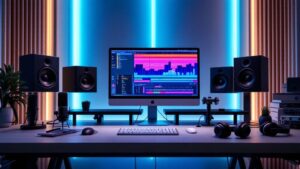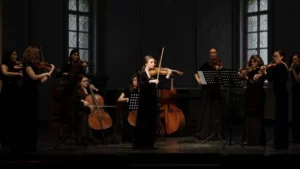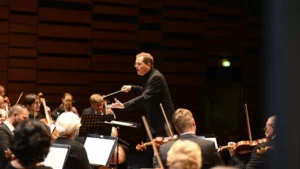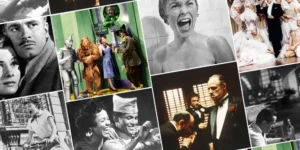In the realm of content creation, music plays an indispensable role. It sets the tone, establishes ambiance, and forms an emotional bridge between the content and its audience. Whether it’s a film, a YouTube video, or an advertisement, the right music can elevate the content, making it memorable and impactful. However, creators often face a dilemma: should they opt for affordable stock music or invest in original compositions? This article delves into the power of music, the challenges of using stock music, and offers insights for creators navigating this musical landscape.
The Emotional Power of Film Music
Music has always played a pivotal role in shaping the emotional landscape of films. From classic movies to contemporary blockbusters, the right soundtrack can elevate a scene, making it unforgettable. Think about the shower scene in Alfred Hitchcock’s “Psycho.” The haunting score by legendary composer Bernard Herrmann is so intertwined with the scene that it’s hard to imagine it without the music. Initially, Hitchcock believed the scene didn’t require music. However, Herrmann composed a piece that Hitchcock eventually used, showcasing the narrative power of film music1.
In the realm of music and film, the two have always been inseparable. Even during the silent film era, cinemas would employ musicians to play music, primarily to mask the noise of projectors and conversations. These musicians often played classical pieces from Western European composers like Tchaikovsky and Wagner, as well as folk and popular music. It was common for the same film to have entirely different musical accompaniments in various cinemas across the country.
The advent of sound-on-film technology led to the unified soundtrack and the practice of hiring composers to craft original scores for movies. Just as an opera composer follows the libretto, a film composer supports the screenplay’s plot. The music must also mirror the screenplay’s mood, encompassing everything from on-screen action to sound effects and dialogues.
Choosing the “right” music for a film can enhance and sometimes even alter the audience’s perception. Imagine replacing John Williams’ iconic “Jaws” theme during the film’s first swimming scene with a serene piece. Instantly, the mood shifts from fear to the tranquility of ocean swimming.
Film music’s power is evident in various movies. For instance, Spike Lee’s “He Got Game” juxtaposes classical composer Aaron Copland’s music with rap group Public Enemy. The film’s opening features a montage of rural American children contrasted with urban youth, set to Copland’s “John Henry.” This piece draws inspiration from the American folk hero John Henry, a legendary steel driver who, according to myth, outperformed a steam-powered machine. The film sequence is edited so that urban youth scenes primarily occur during the clashing hammer sounds in the music, highlighting the disparities between rural and urban youth experiences.
In “Platoon,” a Vietnam War action film, the composer uses contrast to surprise the audience. Instead of a military fanfare or something loud and fast, we hear Samuel Barber’s orchestral strings from “Adagio for Strings.” The tempo, or music speed, plays a significant role in creating the desired effect. Measured in beats per minute, tempo can alter the feel and rhythm of on-screen events.
The next time you watch a film or even your favorite TV show, pay attention to your feelings during a scene and then notice the accompanying music. It’s a testament to the profound impact music has on our emotions and how it shapes our cinematic experiences.
The Challenges of Using Stock Music
In the digital age, content creation has become more accessible than ever. With platforms like YouTube, TikTok, and Vimeo, anyone can become a content creator. However, with this ease comes challenges, especially when it comes to selecting the right music. Stock music, often available at a low cost or even for free, seems like an attractive option for many. But there are inherent challenges with this choice.
One of the primary issues with stock music is its ubiquity. Since it’s readily available and affordable, many creators end up using the same tracks. This overuse can lead to a phenomenon known as “audio fatigue.” Just as we can get tired of hearing the same song on the radio repeatedly, hearing the same stock music track across different content can lead to disinterest or even annoyance1.
Moreover, there’s an emotional disconnect. Music has the power to evoke strong emotions, but when a track is overused, it loses its impact. Imagine watching a heartfelt scene in a movie, only to recognize the background music from a recent advertisement or another YouTube video. This recognition can pull viewers out of the moment, diminishing the emotional impact of the scene2.
Another challenge is the lack of uniqueness. Original compositions are tailored to fit the specific mood and tone of the content. In contrast, stock music is generic, designed to fit a broad range of scenarios. This lack of specificity can make content feel less authentic and less engaging3.
Lastly, there’s the issue of brand identity. For businesses and creators looking to establish a unique brand voice, music plays a crucial role. Using stock music that’s also used by countless others can dilute a brand’s distinctiveness, making it harder to stand out in a crowded marketplace4.
Stock Music vs. Original Compositions
When it comes to selecting music for content, creators often find themselves at a crossroads: should they opt for readily available stock music or invest in original compositions? Both options come with their own set of advantages and disadvantages.
Advantages of Stock Music:
- Cost-Effective: One of the primary reasons creators gravitate towards stock music is its affordability. Especially for those just starting out or working with a tight budget, stock music offers a vast library of tracks without breaking the bank1.
- Accessibility: With numerous platforms offering a plethora of stock music options, finding a track that fits the content’s mood and tone has never been easier.
- Variety: Stock music libraries are vast, offering tracks across genres, moods, and instruments, providing creators with a wide range of choices.
Disadvantages of Stock Music:
- Lack of Uniqueness: As discussed earlier, the widespread use of stock music can lead to content feeling generic and less memorable to the audience2.
- Potential Overuse: The risk of selecting a track that’s already popular or overused is high, leading to audio fatigue among viewers.
- Limited Customization: Stock tracks are fixed in their arrangement and progression, leaving little room for customization to fit specific content nuances.
Advantages of Original Compositions:
- Uniqueness: Original compositions are tailored for specific content, ensuring that the music aligns perfectly with the content’s mood, tone, and message.
- Stronger Emotional Connection: Custom tracks can evoke stronger emotions, enhancing the overall impact of the content3.
- Brand Identity: For businesses, original music can become a part of their brand identity, making them instantly recognizable to their audience.
Disadvantages of Original Compositions:
- Higher Costs: Commissioning original music can be expensive, especially for high-quality compositions.
- Time-Consuming: The process of creating a custom track, from conceptualization to final production, can be lengthy.
- Finding the Right Composer: It’s crucial to find a composer whose style aligns with the content’s vision, which can be a challenging task. That’s whyTuneTailors exist.
The Evolution of Music Creation: The Role of Artificial Intelligence
The music industry is no stranger to technological advancements, and the recent buzz around artificial intelligence (AI) in music creation is hard to ignore. However, as a creative music agency, Tunetailors believes in the irreplaceable value of human touch in music. Here’s our take on the current state of AI in music:
- Automated Compositions: While AI algorithms can generate compositions by analyzing vast datasets of existing music, the results often lack the depth, emotion, and intricacy that human composers bring. Most AI-generated tracks, especially those longer than 15 seconds, tend to be repetitive and lack nuance.
- Customization: Some AI-driven platforms offer real-time customization of tracks. However, these are mostly limited to simple beats in genres like EDM. When it comes to complex compositions or scores, AI falls short.
- Learning and Adapting: While it’s true that AI systems can learn and adapt, the music they produce still lacks the authenticity and emotional resonance of human-composed pieces.
Challenges and Concerns:
- Authenticity: AI-generated music often feels generic. It lacks the soul, emotion, and unique touch that comes from human experience and creativity.
- Over-reliance: Relying heavily on AI for music creation can stifle genuine creativity. At Tunetailors, we believe in the power of human innovation and the magic that composers bring to their creations.
- Copyright Issues: AI-generated music introduces a plethora of copyright concerns. Who owns the rights to a machine-created piece? And how do usage rights work in such scenarios?
While AI has made strides in many sectors, its role in music creation is still embryonic. Current AI-generated music projects have shown limitations, especially when compared to the rich tapestry of human-composed music.
Recommendations for Content Creators
Choosing the right music for your content is a critical decision that can significantly influence audience engagement and perception. Here are some recommendations to help content creators make informed choices:
- Understand Your Audience: Before selecting music, it’s essential to have a clear understanding of your target audience. What are their preferences? What emotions do you want to evoke? The answers to these questions can guide your music selection.
- Prioritize Originality: While stock music is easily accessible and cost-effective, it may not always be the best choice. Consider investing in original compositions or licensing unique tracks to set your content apart and create a memorable experience for your audience.
- Stay Updated on Copyright Laws: With the rise of AI-generated music and the frequent use of stock tracks, it’s crucial to be aware of copyright issues. Ensure that you have the necessary permissions and licenses for any music you use.
- Seek Feedback: Regularly gather feedback from your audience regarding the music in your content. This can provide insights into what works and what doesn’t, allowing you to make more informed decisions in the future.
- Collaborate with Musicians: Building relationships with composers and musicians can be beneficial. Collaborative efforts can lead to unique compositions that resonate more deeply with your audience.
Conclusion
Music, with its profound emotional resonance, remains an integral component in the realm of content creation. Its power to shape cinematic experiences, evoke emotions, and establish ambiance is unparalleled. In today’s digital age, while the convenience of stock music offers a tempting choice, it comes with challenges such as overuse, lack of uniqueness, and potential dilution of brand identity. On the other hand, original compositions, though potentially costlier, provide a unique voice and a deeper emotional connection to the content.
While AI offers automation and real-time customization, it often lacks the depth, nuance, and emotional richness inherent in human-composed music. Moreover, the realm of AI-generated music introduces complex issues surrounding authenticity and copyright.
In the evolving landscape of music in content creation, it’s essential for creators to strike a balance. Whether opting for stock music or original compositions, the key lies in understandingyour audience and ensuring that the chosen music aligns seamlessly with the content’s vision and message.
In today’s fast-paced digital world, the power of sound cannot be underestimated. It has the potential to evoke emotions, tell stories, and create lasting impressions. AtTuneTailors, we understand this power and are dedicated to harnessing it to bring your creative vision to life. Our team of professional composers, sound designers, and audio engineers, many of whom have been trained at prestigious conservatories, are passionate about collaborating with artists, filmmakers, musicians, and content creators like you.











